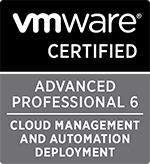Category : VRealize Automation

Written by Christopher Lewis on January 10, 2017 .
In this post, which is part of a larger series of posts for the VMware VCAP6-CMA Deploy exam, we will step through the configuration of the VMware vRealize Automation 6.x Appliance.

Written by Christopher Lewis on January 10, 2017 .
In this post, which is part of a larger series of posts for the VMware VCAP6-CMA Deploy exam, we will step through the configuration of the VMware Identity Appliance for vRealize Automation 6.x.

Written by Christopher Lewis on January 10, 2017 .
In this post, which is part of a larger series of posts for the VMware VCAP6-CMA Deploy exam, we will step through the configuration of the VMware Identity Manager Appliance for vRealize Automation 6.x.

Written by Christopher Lewis on January 9, 2017 .
In this post, which is part of a larger series of posts for the VMware VCAP6-CMA Deploy exam, we will step through the installation of the VMware vRealize Automation 6.x appliance.

Written by Christopher Lewis on December 22, 2016 .
In this post we cover the VCAP6-CMA Deploy - Objective 3.2: Deploy and Manage Certificates and Access Control

Written by Christopher Lewis on November 22, 2016 .
Find out all about vRealize Automation 7.2 and where to get hold of it!

Written by Christopher Lewis on November 15, 2016 .
In this post we walkthrough how to install the vRealize Automation IaaS Management agent.
Written by Christopher Lewis on November 5, 2016 .
In this final post of the series, we walkthrough how to replace the Package Signing Certificate certificate in VMware vRealize Orchestrator 7.x.
SSL Certificates VMware vRealize Automation vRealize Orchestrator
Written by Christopher Lewis on November 5, 2016 .
In this third post of the series we walkthrough how to replace the SSL certificate on the embedded vRealize Orchestrator 7.x
SSL Certificates VMware vRealize Automation vRealize Orchestrator

Written by Christopher Lewis on November 5, 2016 .
In this second post of the series we walkthrough how to replace the VAMI certificate in vRealize Automation 7.x
SSL Certificates VMware vRealize Automation vRealize Orchestrator
